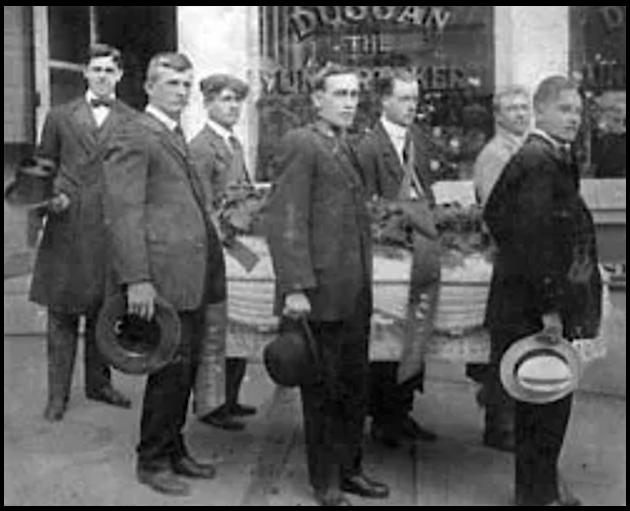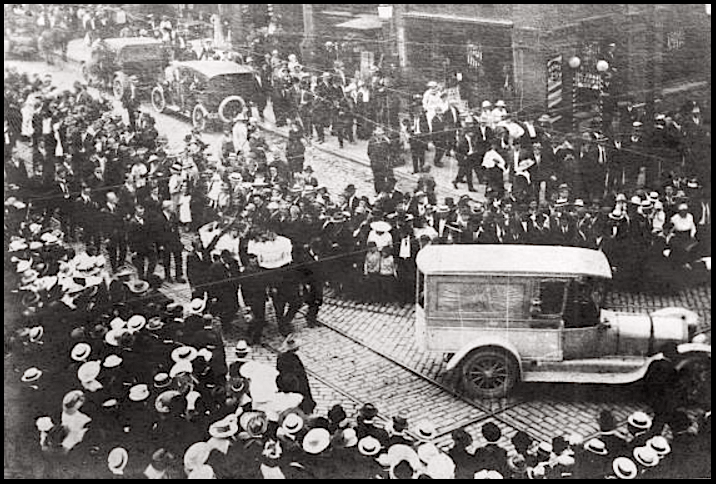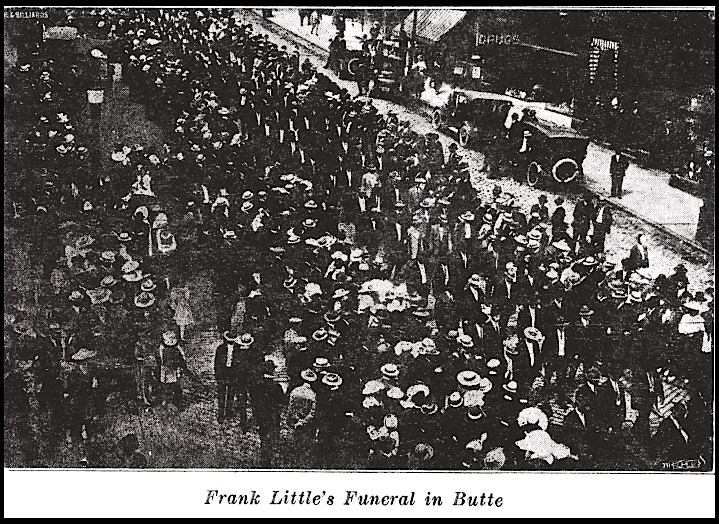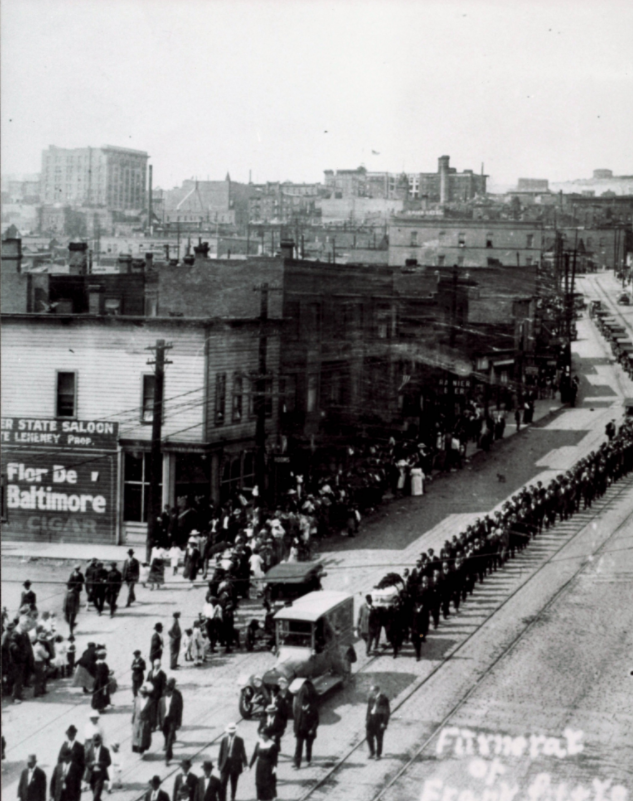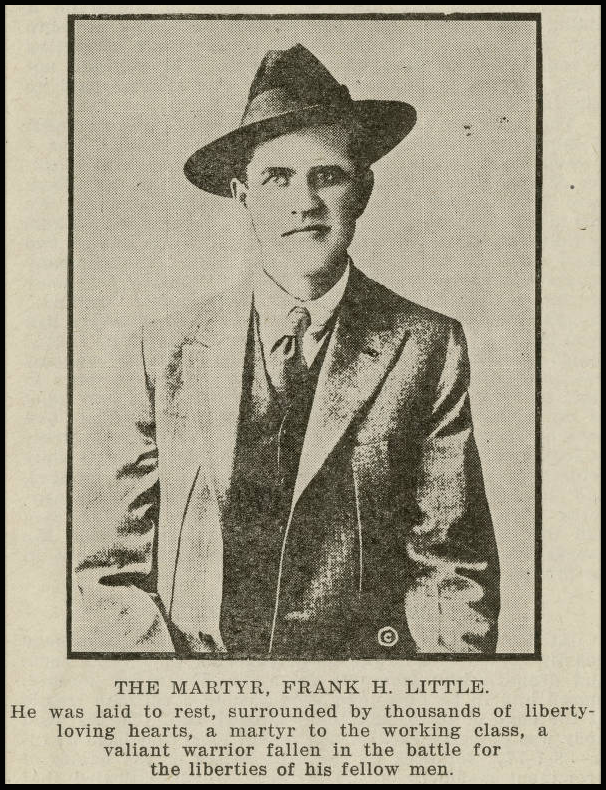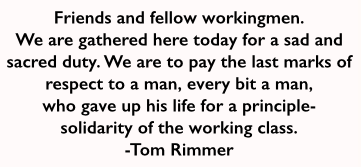
Hellraisers Journal, Wednesday August 8, 1917
Butte, Montana – Thousands March to Honor Martyr Frank Little
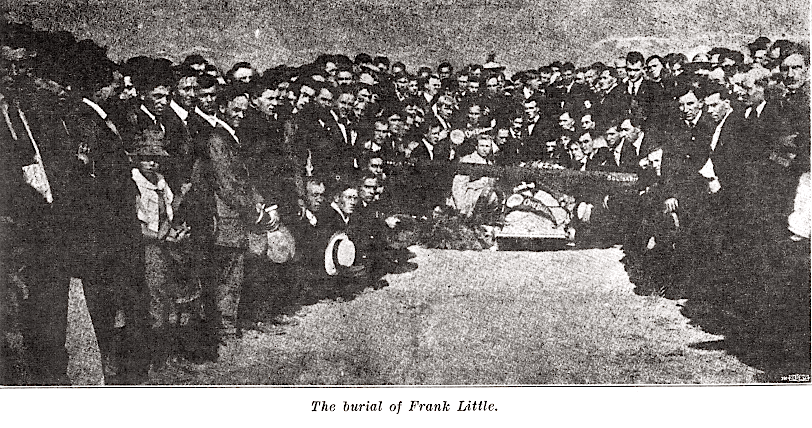
—–
On Sunday August 5th there was held the largest funeral ever held in the city of Butte, and, perhaps, in the state of Montana. Thousands of mourners marched behind the casket carrying the remains of Frank Little, the valiant warrior who gave his life in freedom’s cause.
From The Anaconda Standard of August 6, 1917:
The voice of the mine owners could not refrain from sniping at the striking miners, their union (not affiliated with the I. W. W.), nor the union represented by Frank Little, the Industrial Workers of the World. Nevertheless, the report on FW Little’s funeral appears to be, for the most part, accurate.
LARGE FUNERAL NO DISORDER
—–
DEMONSTRATION AND A SPECTACLE
MARK FINAL TRIBUTE TO FRANK LITTLE
—–MANY FRIENDS MARCH
—–Women in the procession, which is made up of more than three thousand-Red sashes and other I. W. W. emblems displayed- Moving pictures are taken-Stars and Stripes shown for a while, then removed. No religious service-Brief remarks were made at the grave.
—–
—–
Frank H. Little was buried yesterday.
If the I. W. W. leader who was lynched Thursday morning by some misguided men who took upon themselves the execution of a vengeance against unbridled, unpatriotic agitation, looked upon his own funeral he may have concluded that his experience was not without its reward.
If the spirt of the departed is not without the sensation of vanity, the spirit of Little must have experienced a feeling of pride over the demonstration that was accorded him in Butte yesterday afternoon [August 5th] when 10,000 and more people crowded the streets as the funeral procession wended its four-mile journey from the federal building on North Main street to Mountain View cemetery, south of the city, and several thousand men and women marched ahead of the body, which was borne upon the shoulders of men treading slowly in the march to the grave.
—–
Silently, orderly and impressively 3,500 sympathizers, four abreast with the thud, thud, thud of a moving army, marched down the granite-paved hill, passing each group of the thousand silent spectators for 30 minutes, on toward the silent city to the south.
The funeral was arranged as a demonstration and a spectacle, and as such it was a great success. Photographers and moving picture men had been engaged to make a record of it, and all the staging and all conditions were ideal for their work.
The Procession.
—–
The procession formed on Main street, with the head of it just north of Broadway in front of the Hirbour building. At the very head of it an American flag was carried. The committee that secured permission for the parade was informed that the Stars and Stripes must be in the lead and that no other flag of any description should be carried.
The American flag belonging to the electrical workers’ union was carried by one of their members, who had been appointed as color bearer. At his right walked Tom Campbell, head of the Metal Mine Workers’ union, and at his left walked R. F. Dunn of the electrical workers, who has worked so strenuously to turn over his organization to Campbell and the I. W. W.
Following these three came a volunteer band, consisting of members of the musicians’ union. They included members of different bands, but none of them wore the uniforms of their organizations.
The Pearce-Connolly club had the place of honor at the head of the parade. There were 120 members of this organization on line, and they wore large green sashes decorated with rosettes of yellow and green. Those who are members of the metal mine workers wore their white buttons pinned on the sashes. A number of members who were not provided with the sashes wore little bow knots of yellow and green. This section was under the direction of Denny Harrington as marshal. He was formerly a city police officer during the socialist regime. Attorney McGrath also marched with the club.
Women in Line.
Following the Pearce-Connolly club marched about 200 women. They were nearly all Finnish women. Half a dozen of them carried babies or wheeled small children in go-carts. They marched the entire distance to the cemetery and very few of them had to fall out of line on account of fatigue.
Members of the committees of the metal mine workers’ organization came next. Following them were a number of members of the electrical workers’ union and they carried the union banner. This was the only banner in the entire parade.
Following these came a large number of members of other unions, although none of these organizations was officially in line. There were members of the street railway men’s union, of the hodcarriers’ union and a large representation of the workingmen’s union. The cement workers and some of the building trades were represented by members who are of radical views.
Miners Turn Out.
Next came the members of the metal mine workers’ organization. These formed the major part of the parade and it was estimated that there were between 2,000 and 2,500 of these.
The marshals in charge of this division all wore small sashes of red ribbon. The miners marched four abreast and they walked in close formation. Near the end of this division were a number of women who did not get around in time to march with the first section.
—–
Following the miners came the auto hearse at each side of which walked three honorary pallbearers with large red sashes. Behind the hearse came the casket carrying the body of Little and carried on the shoulders of six giant miners, all of whom over six feet in height.
Each of these wore large red sashes and following them, walking in double file, came 100 men composing the guard of mourners. They marched with bared heads. Each wore a large red sash and they consisted of Finlanders, Austrians, Bulgarians and Turks almost entirely. Many of these were prominent members of the Industrial Workers of the World who had come to Butte to attend the funeral of Little.
Following these at the end of the procession were about a dozen automobiles carrying friends of the dead man and a delegation of miners.
The procession moved down Main street to Park, where it turned east, to Arizona street and marched down Arizona and Utah avenue to Front, where it turned over to Harrison avenue and marched directly to the Mountain View cemetery.
Many Spectators.
The streets along the line of march were crowded by spectators, who watched the parade as it passed. There were no demonstrations of any kind along the line. The marchers walked by swiftly and silently and the thousands who watched them were remarkably quiet.
The entire police force was on duty. At each corner in the business district officers were stationed to keep back the crowds, while a reserve detail was held at the city hall to respond to any emergency call. They were not called out, however.
The head of the parade reached he corner of Park and Main street at exactly 2:04. The last auto in the parade passed the same corner at 2:35.
Several counts of the number in the parade were made. The one made by the Standard representative showed 3,155 men and 236 women in line, or a total of 3,491. This included every person.
The only thing approaching a disturbance was near Park and Main, when someone with a machine insisted on forcing his way through the crowd of sightseers who were watching the parade. He kept his horn honking and after some protests from the crowd he was given the right of way to get into West Park street.
Flag Not Displayed.
The American flag which was displayed by the marchers when going through the business district was not carried by the marchers when the procession arrived at the cemetery. After passing through the business district the procession moved slowly and people who lived on Harrison avenue waited for two hours for the cortege to a pass. The marchers began to drop out before they came to Front street and when the Harrison hotel on Harrison avenue was reached the American flag was no longer seen. The casket and the 100 I. W. W.’s who followed it moved through the ranks of marchers and took the lead.
The body, which had been carried on the shoulders of the I. W. W.s to the city line, was placed in the automobile hearse when the city limits were passed. At this point a large part of the marchers left the parade and stared to walk back to town as individuals or in groups. When the crowd passed down Arizona street there were hundreds of people on the sidewalks. Windows of blocks and offices contained people who secured these vantage points to see the parade. The body at that time was being carried on the shoulders of the I. W. W. bodyguard, who worked in relays of six each. People who were unable to be uptown because of the strike of the street car men congregated along the line of march, but there was no demonstration.
The Harrison avenue viaduct and other vantage points which enabled people to watch the gradually thinning lines were crowded and the marchers proceeded in the same quiet way after the lines had passed through the business section.
Marchers Drop Out.
After the procession reached Cobban street there was a big falling off in the number of marchers. Many of the women who had marched with their little children left the procession and then the American flag disappeared from the line. The I. W. W.’s who wore the red sashes then went to the head of the procession, the women following; then the members Pearce-Connolly club, who remained, followed by other marchers.
It is four miles from the Daly statue to the cemetery and the marchers had dwindled to about 400 when the body arrived at the graveyard, but a body of some 25 women, several with children, completed the march and joined in the services. The bodyguard of the I. W. W. was closely grouped about the hearse when it drove into the cemetery.
Take Moving Pictures.
A moving-picture man who had been engaged by the men in charge of the parade took a picture of the empty grave and of the crowd which had gathered in anticipation of the burial. Many of those who were there before the weary marchers arrived were motorists who gathered to watch the final setting of the act which has aroused so much interest in Butte.
The body was carried to the grave and deposited on the ropes which are used to lower the casket. Two groups of I. W. W., one line within another, then formed around the grave and, at the direction of the motion-picture operator, posed for the films.
A banner reading “The one big union, universal, the I. W. W.” was held over the casket, which was so turned that the red silk could be taken by the camera. Other men who wore the sashes held up the banners reading,
A martyr for solidarity.
“Stand back, the picture will be spoiled,” said one of the I. W. W. marshals to a group that crowded too closely around the reds. Then those who had red carnations held them up and an effort was made to have shown everything that was red at the grave. The operator turned the reel, and the last scenes of the tragedy were taken for motion pictures. Then, when the simple exercises were about to be held, the operator wanted to make another picture and everybody posed again, this time with some Finn women and children grouped about the casket.
Silk Flags on Casket.
As the casket was about to be lowered into the grave the flowers, the majority of which were red carnations and roses, were removed for distribution in the crowd. Red silk handkerchiefs and other cloth articles, all red, were tossed onto the casket as the last mark of honor by the Industrialists who were gathered around the grave.
Tom Rimmer, who had been selected to deliver the eulogy, then said:
Friends and fellow workingmen. We are gathered here today for a sad and sacred duty. We are to pay the last marks of respect to a man, every bit a man, who gave up his life for a principle-solidarity of the working class. The degenerates who took him from bed in the middle of the night and murdered him in a more vile fashion than they would a dog did not destroy his spirit. They found that he met death in the same way he had fought for you and for me. Where he goes now we do not know, but that he lived true to a principle no one can deny. He was devoted to a class struggle and to liberty. His deeds and words were good deeds and words, and his memory lives with us and will lead us.
We now consign him to a world we know nothing of.
Flowers Distributed.
As Rimmer continued his eulogy the red flowers were thrown to the crowd. John Shannon wore a red sash and distributed flowers among the women around the group. One woman advised others to “take it home and press it in memory of this man.”
Tom Campbell, who did not wear the revolutionary red, did not take part in the proceedings, but stood near the grave. James Treanor, who said he was secretary of the Pearce-Connolly club at the time he was arrested for spreading literature against registration, June 5, and who was released by order of Federal Judge Bourquin, was prominent among those around the grave. Treanor was active as an Industrialist before he came to Butte and became a member of the Pearce-Connolly club. Yesterday Treanor, who on June 4, the time of his arrest, denied he was an Industrialist, wore the revolutionary red. A group of men about the grave, Austrians, Bulgarians and Turks, all wore the sashes.
It had been announced that telegrams protesting against the lynching of Little would be read at the grave, but they were not.
“The Marsellaise”
“Let’s sing a revolutionary song to finish the ceremony,” said one member, as the last of the flowers were thrown to the crowd as souvenirs.
“Let it be ‘the Marseillaise,'” said another.
The glee club which was to sing the French anthem, which is the revolutionary song of the Industrialists, was not present, as many of the woman members had dropped out long before the casket arrived at the cemetery.
There was a snatch of the song. Then it died away. The band of red-sashed men began to move away and only a few remained about the grave of the man they were about to bury as a martyr to the cause of the Industrial Workers of the World.
“Let Williams, he is a marked man, speak,” suggested one of the “reds,” who remained.
Williams is an I. W. W. organizer who came to Butte about the time Little did. William was at the graveside. He said he was too much overcome by emotion to speak. He was asked again, and a third time to deliver an eulogy to his friend, but he left the grave without speaking.
There was no minister present and one man at the graveside poured a shovel of dirt on the casket and the crowd disbanded.
———-
[Photographs added.]
SOURCE
The Anaconda Standard
(Anaconda, Montana)
-Aug 6, 1917, page 5
http://www.genealogybank.com/
IMAGES
Frank Little Funeral, Casket Duggans, Butte Aug 5, 1917
https://www.iww.org/es/history/biography/FrankLittle/1
Frank Little Butte Funeral Aug 5, 1917, Reuther 5109
http://reuther.wayne.edu/node/12852
Frank Little, Butte Funeral, Lbr Def, Aug 1926
Frank Little Funeral, At Grave
https://www.marxists.org/history/usa/pubs/labordefender/1926/v01n08-aug-1926-LD.pdf
Frank Little Funeral, Great Uncle, Butte Aug 5, 1917
http://rebrn.com/re/funeral-procession-for-my-great-uncle-frank-little-who-was-lynch-369063/
Frank Little Martyr, Truth About Butte Tompkins, 1917
http://cdm16013.contentdm.oclc.org/cdm/ref/collection/p267301coll1/id/4294
See also:
Frank Little and the IWW:
The Blood That Stained an American Family
-by Jane Little Botkin
University of Oklahoma Press, May 25, 2017
https://books.google.com/books?id=gBskDwAAQBAJ
Note: Jane Little Botkin is the great grand niece of Labor Martyr Frank Little. This is the definitive life story of Frank Little and of the long journey to Remembrance for his family.
According to the El Paso Herald of August 6, 1917
http://chroniclingamerica.loc.gov/lccn/sn88084272/1917-08-06/ed-1/seq-2/
-the casket was carried on the shoulders of Little’s fellow workers all the way to the cemetery:
Twenty men in relays carried the casket on their shoulder to the cemetery.
The Truth About Butte, page 43
-by George R Tompkins
MT, Sept 20, 1917
http://cdm16013.contentdm.oclc.org/cdm/ref/collection/p267301coll1/id/4294
Tompkins also states that the casket was carried to the cemetery:
The funeral of Little was the largest ever witnessed in the state. Thousands marched in the line of the funeral procession the entire distance of five miles from the city to the cemetery. Thousands upon thousands of people banked the streets along the line of the funeral procession, and in homage to the dead stood with bowed, uncovered head, as the solemn procession passed.
The coffin in which Little’s body rested was borne on the shoulders of his fellow laborers the entire distance. He was laid to rest surrounded by thousands of liberty-loving hearts, a martyr for the working class, a valiant warrior fallen in the battle for the liberties of his fellow men.

